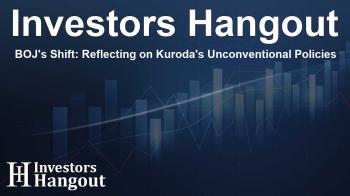BOJ's Shift: Reflecting on Kuroda's Unconventional Policies

Bank of Japan Reassesses Kuroda's Legacy
The Bank of Japan (BOJ) is undergoing a significant transformation as it critically evaluates the radical policies implemented by its former governor, Haruhiko Kuroda. In a surprising move, the BOJ acknowledged that Kuroda's stimulus strategies did not significantly alter consumer behavior as intended. This marks a notable shift from the previous decade characterized by aggressive monetary easing efforts.
Understanding the Review's Findings
Recently, the BOJ released a comprehensive review detailing the impacts of Kuroda's monetary policies. The findings indicated potential long-lasting negative effects stemming from these unconventional approaches, particularly the strain placed on the bond market due to the bank's extensive quantitative easing measures.
The BOJ's Commitment to Policy Normalization
The results of this review have strengthened the BOJ's resolve to gradually normalize its monetary policy. Kazuo Ueda, who succeeded Kuroda as governor, expressed concerns about the lingering uncertainties associated with the massive monetary easing. Ueda emphasized the various side effects of these policies, some of which have yet to manifest fully.
Historic Context of Japan's Monetary Policy
Over the past 25 years, Japan has grappled with deflation and sluggish economic growth, prompting the BOJ to explore unconventional strategies, including zero interest rates and quantitative easing. These measures have inspired similar strategies among global central banks, particularly during economic crises, such as the recent COVID-19 pandemic.
Analysis of Policy Effectiveness
Upon Ueda's appointment, he launched a review to critically assess the outcomes of various unconventional tools adopted during the battle against deflation. The BOJ's most debated measure, initiated in 2013 under Kuroda, involved a vast asset purchase program combined with negative interest rates and bond yield control.
Framing Public Perception through Monetary Policy
The core idea was for the BOJ to change public expectations surrounding inflation through bold, unexpected monetary actions. This approach reflected a departure from earlier beliefs held by Kuroda’s predecessors, who argued that monetary policy had limited capacity to sway public perceptions.
Divided Opinions Among Economic Experts
In the aftermath of Kuroda's policies, economists are divided. Some praise the measures for their innovative nature, while others caution against the substantial costs incurred. During his departure news conference, Kuroda defended his approaches, labeling them effective and appropriate while expressing disappointment over the inability to consistently achieve the BOJ's inflation target of 2%.
BOJ's Balanced Overview
The recent policy review aimed to provide a balanced evaluation of Kuroda's strategies, assessing which were successful and which fell short. Utilizing economic models, the BOJ explored how Kuroda's stimulus impacted inflation expectations. The results revealed that while there was some influence on public perception, it was insufficient to drive inflation to the targeted levels.
The Road Ahead for Japan's Economy
Japan's long-standing deflationary mindset has ingrained skepticism among businesses and households regarding wage and price increases, posing a significant challenge for the BOJ's efforts. Research indicated that despite the stimulated growth of the GDP by approximately 1.3% to 1.8% on average, inflation only increased by a mere 0.5 to 0.7 percentage points.
Future Implications and Discussions
Many within the BOJ hope this review will mitigate tensions between advocates and critics of Kuroda’s strategies. However, some academics remain skeptical about whether the bank has thoroughly examined the shortcomings of past policies. Hiroshi Yoshikawa, a professor emeritus, voiced concerns that the review's focus on negative perceptions overshadowed a necessary critique of Kuroda's theoretical framework that may have contributed to the failure to reach the inflation goal.
Frequently Asked Questions
What is the main focus of the BOJ's recent policy review?
The review primarily assesses the effectiveness of former governor Haruhiko Kuroda's unconventional monetary policies and their lasting impacts on Japan's economy.
How did Kuroda's policies affect Japan's inflation rates?
Despite stimulating GDP growth, Kuroda's policies contributed only a minimal increase in inflation, failing to meet the BOJ's 2% target.
What challenges does the BOJ face with public perception of inflation?
A long-standing deflationary mindset among the public poses challenges to the BOJ in altering expectations about wage and price increases.
What are the implications of the BOJ's critical review?
The review aims to foster a clearer understanding of the strengths and weaknesses of Kuroda's policies, guiding the BOJ's future monetary strategies.
Who succeeded Kuroda as the governor of the BOJ?
Kazuo Ueda succeeded Haruhiko Kuroda as the governor of the Bank of Japan, taking office in April 2023.
About Investors Hangout
Investors Hangout is a leading online stock forum for financial discussion and learning, offering a wide range of free tools and resources. It draws in traders of all levels, who exchange market knowledge, investigate trading tactics, and keep an eye on industry developments in real time. Featuring financial articles, stock message boards, quotes, charts, company profiles, and live news updates. Through cooperative learning and a wealth of informational resources, it helps users from novices creating their first portfolios to experts honing their techniques. Join Investors Hangout today: https://investorshangout.com/
Disclaimer: The content of this article is solely for general informational purposes only; it does not represent legal, financial, or investment advice. Investors Hangout does not offer financial advice; the author is not a licensed financial advisor. Consult a qualified advisor before making any financial or investment decisions based on this article. The author's interpretation of publicly available data shapes the opinions presented here; as a result, they should not be taken as advice to purchase, sell, or hold any securities mentioned or any other investments. The author does not guarantee the accuracy, completeness, or timeliness of any material, providing it "as is." Information and market conditions may change; past performance is not indicative of future outcomes. If any of the material offered here is inaccurate, please contact us for corrections.
